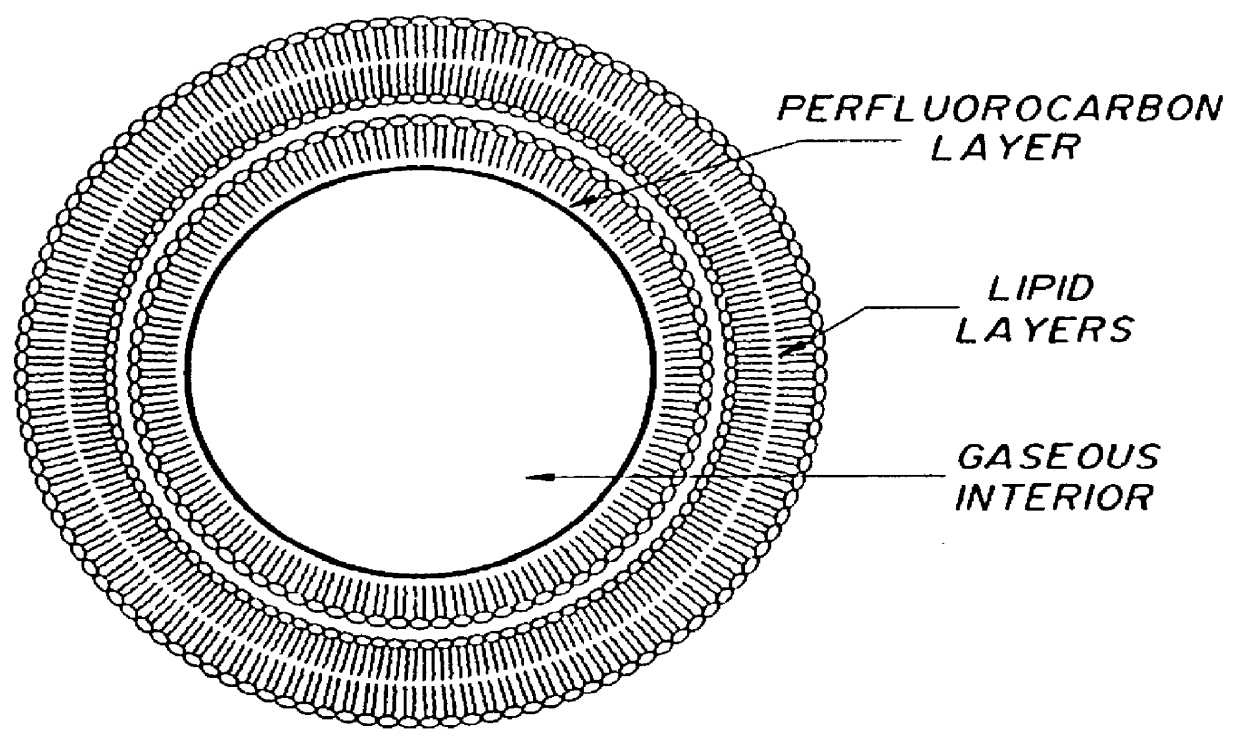Method of computed tomography using fluorinated gas-filled lipid microspheres as contrast agents
a computed tomography and lipid microsphere technology, applied in the direction of ultrasonic/sonic/infrasonic diagnostics, dispersion delivery, diagnostics, etc., can solve the problems of bubbles not encapsulated, no suggestion that these compositions would be useful as contrast media, and no suggestion that these liposomes could serve as contrast media for computed tomography
- Summary
- Abstract
- Description
- Claims
- Application Information
AI Technical Summary
Benefits of technology
Problems solved by technology
Method used
Image
Examples
example 1
This example describes the preparation of gas and gas precursor filled microspheres within the scope of the invention.
DPPC (77.5 mole %), DPPA (12.5 mole %), and DPPE-PEG 5000 (10 mole %) were introduced into a carrier solution of normal saline with glycerol (10 wt. %) and propylene glycol (10 wt. %). To this mixture was added perfluoropentane and a portion of the suspension (6 mL) was placed in a 18 mL glass vial and autoclaved for 15 minutes at 121.degree. C. The resulting translucent suspension was allowed to cool to room temperature. No appreciable foam could be seen was observed, but gentle shaking produced a few small bubbles at the top of the suspension. Shaking on a Wig-L-Bug.TM. (Crescent Dental Mfg. Corp., Lyons, Ill.) for 2 minutes resulted in a dense foam that substantially filled the entire volume of the vial.
Samples of the lipid / perfluoropentane (PFP) suspension, with and without shaking, were scanned by computed tomography using a Siemens DRH Somatom Ill. (Siemens, Is...
example 2
This example is directed to an analysis the effect of manual and mechanical shaking on microsphere size.
A lipid / PFP suspension was prepared as described in Example 1. A sample of the suspension was shaken at room temperature manually (much less vigorously than with the Wig-L-Bug mechanical shaker utilized in Example 1). Substantially no foam was produced, only a few bubbles at the top of the liquid layer. However, when the sample was warmed to body temperature, 37.degree. C., i.e., above the 27.5.degree. C. boiling point of the perfluoropentane, and shaken manually, foam readily appeared and filled the entire vial. When the foam produced by the Wig-L-Bug mechanical shaker at room temperature was compared to the foam produced manually at body temperature, it was noted that the microspheres produced by manual shaking were somewhat larger than the microspheres produced by the Wig-L-Bug mechanical shaker. The microspheres produced by manual shaking rose to the surface more quickly than ...
example 3
This example is directed to the formation of stabilized gas-filled microspheres comprising lipid bilayers with polyvinyl alcohol.
The effect of a polymer, namely, polyvinylalcohol, on the size of microspheres containing perfluorocarbons is illustrated in this example. Gas-filled microspheres comprising a lipid were prepared by the addition of 5 mg / mL of a suspension of DPPC:phosphatidic acid, and DPPE-PEG 5000 in a molar weight ratio of 82:8:10 in a vehicle containing 5% by weight of polyvinylalcohol (weight average M.W. 50,000, 99+% hydrolyzed) in normal saline. To this mixture was added 50 .mu.L of perfluoropentane. An identical suspension to the above described suspension was also prepared except that the vehicle was normal saline, glycerol, and propylene glycol in a ratio of 8:1:1, v:v:v (Spectrum Chemical Co., Gardena, Calif.). The suspensions were then autoclaved at 121.degree. C. for 21 minutes in a Barnstead / Thermolyne autoclave (Barnstead / Thermolyne, Rancho Dominguez, Calif)...
PUM
 Login to View More
Login to View More Abstract
Description
Claims
Application Information
 Login to View More
Login to View More - R&D
- Intellectual Property
- Life Sciences
- Materials
- Tech Scout
- Unparalleled Data Quality
- Higher Quality Content
- 60% Fewer Hallucinations
Browse by: Latest US Patents, China's latest patents, Technical Efficacy Thesaurus, Application Domain, Technology Topic, Popular Technical Reports.
© 2025 PatSnap. All rights reserved.Legal|Privacy policy|Modern Slavery Act Transparency Statement|Sitemap|About US| Contact US: help@patsnap.com



